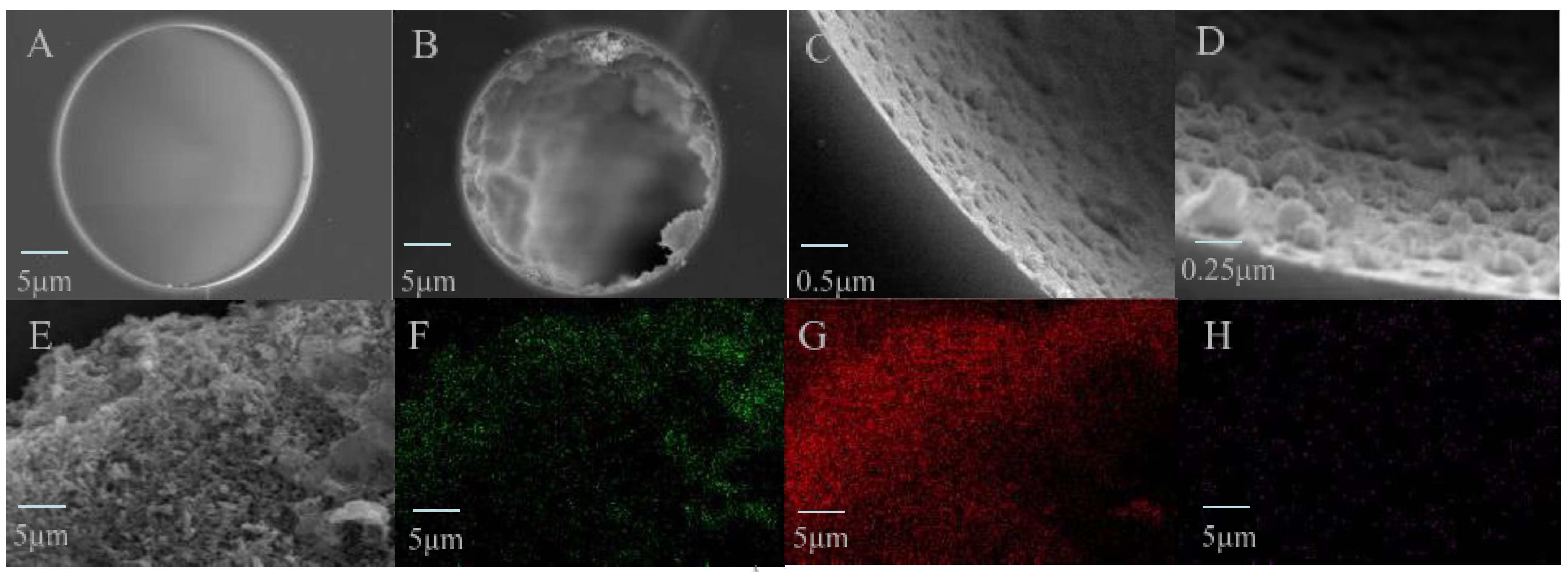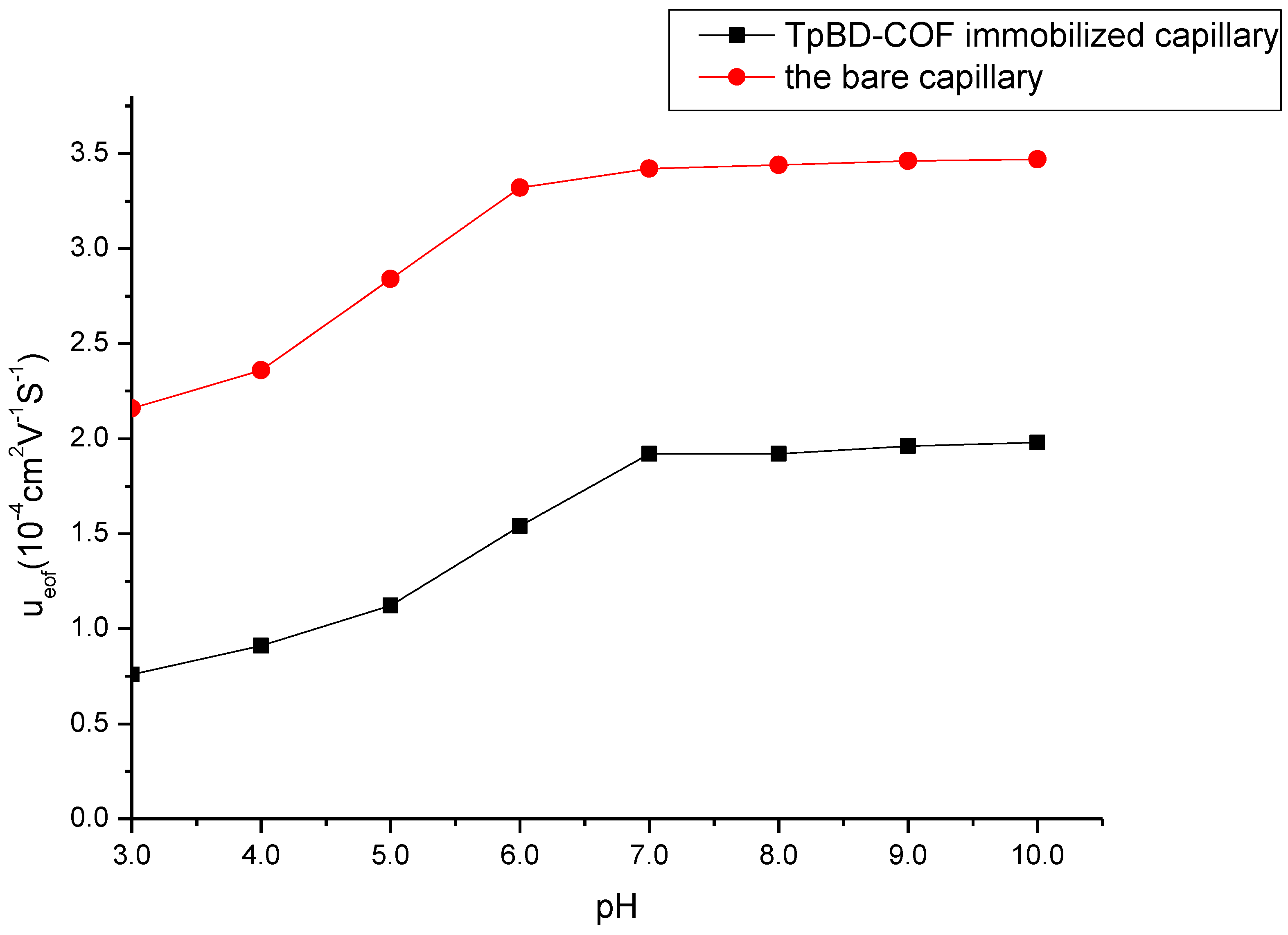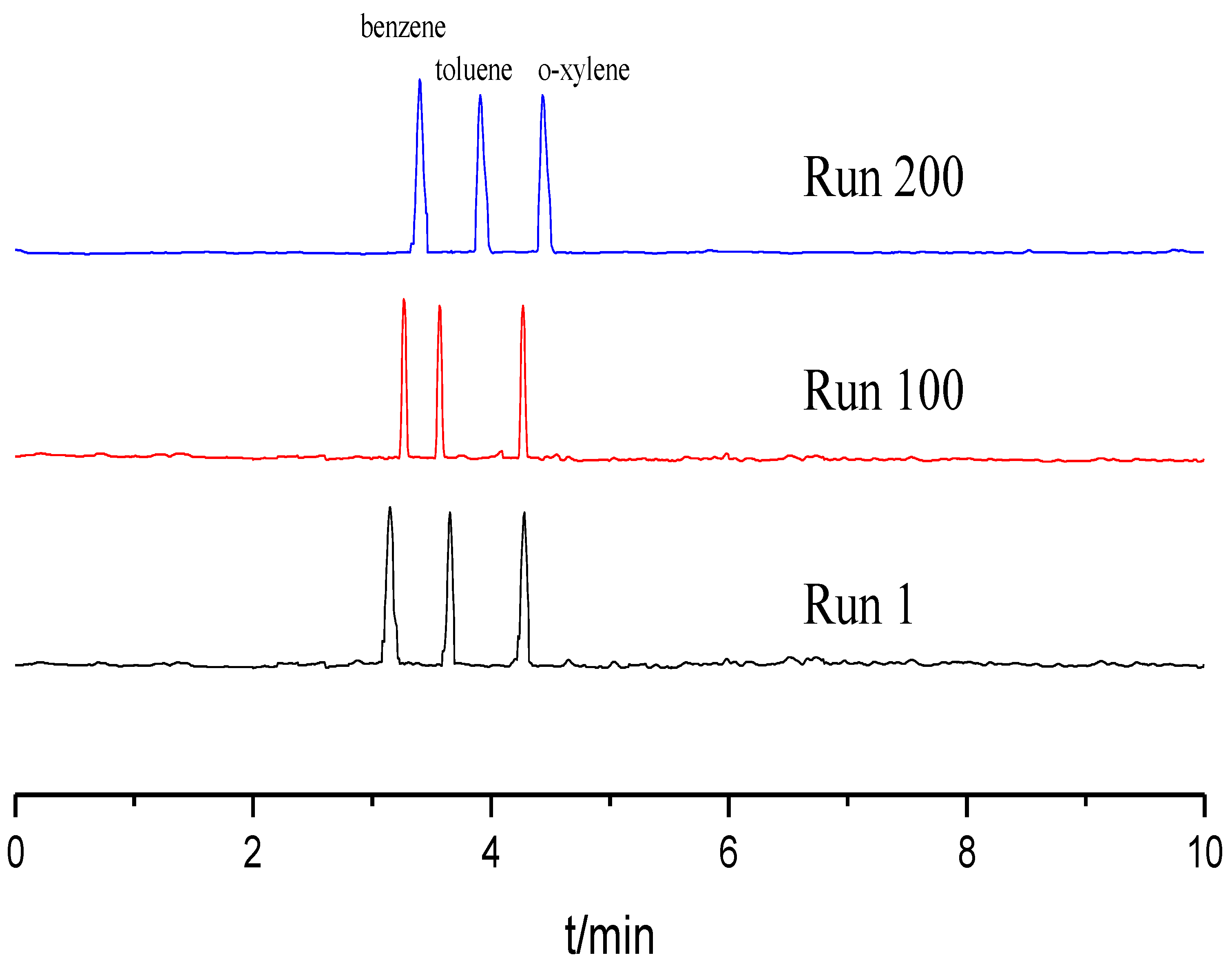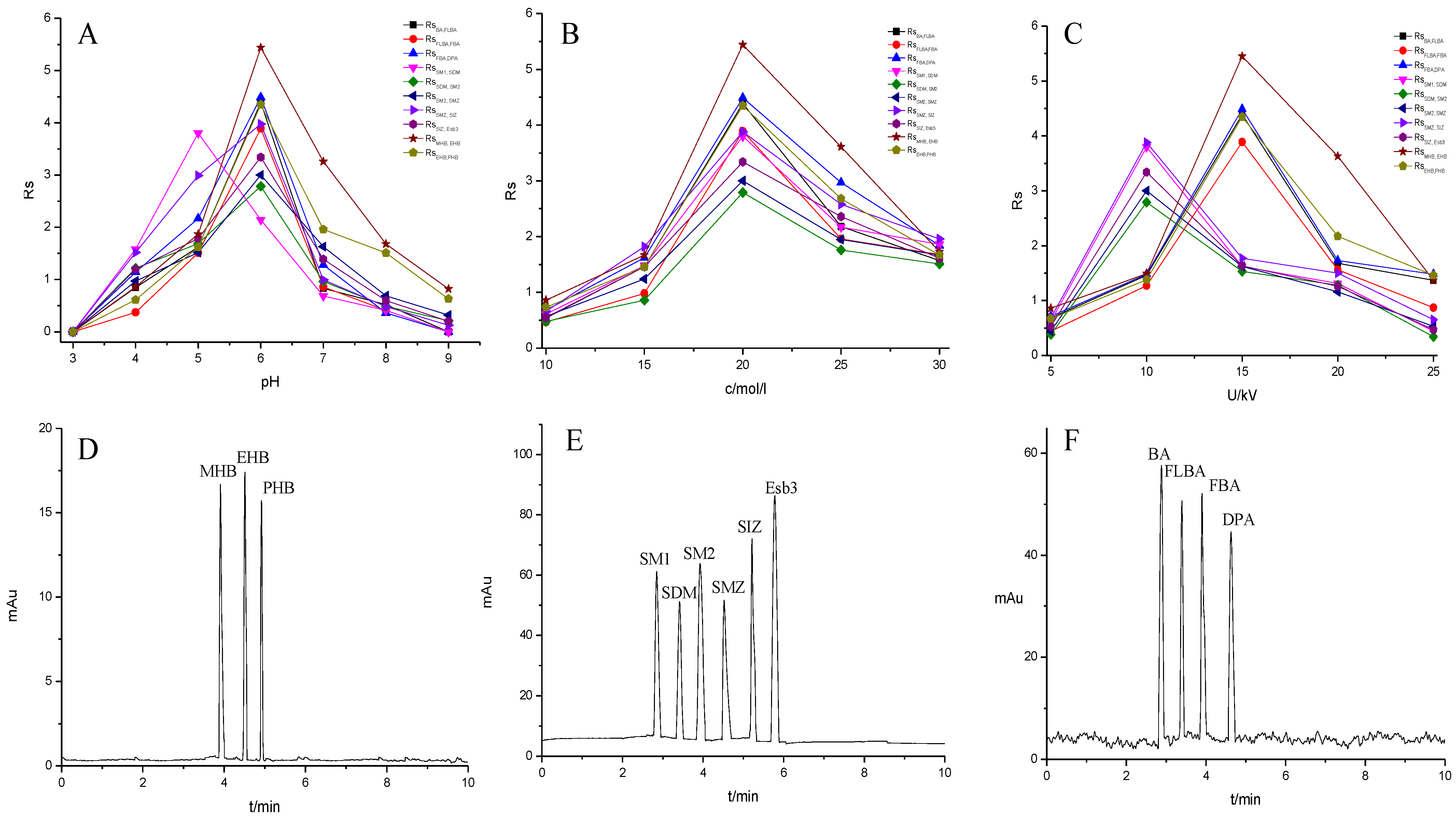Open Tubular Column Immobilized with Covalent Organic Frameworks for Rapid Separation of Small Molecular Compounds by Capillary Electrochromatography
Abstract
:1. Introduction
2. Materials and Methods
2.1. Reagents and Materials
2.2. Instrumentation
2.3. Preparation of Aldehyde Group-Functionalized Capillary
2.4. Preparation of the TpBD COF Immobilized Capillary
2.5. CEC Conditions
2.6. Preparation of Sample Solution
3. Results and Discussion
3.1. Preparation and Characterization of the TpBD COF Immobilized Capillary
3.2. Evaluation of the TpBD COF Immobilized Capillary
3.2.1. EOF Analysis
3.2.2. Reproducibility and Stability
3.2.3. Separation Performance
3.3. Separation of the Small Molecular Compounds
3.4. Methodological Validation
4. Conclusions
Author Contributions
Funding
Institutional Review Board Statement
Informed Consent Statement
Data Availability Statement
Conflicts of Interest
References
- Xie, S.M.; Yuan, L.M. Recent progress of chiral stationary phases for separation of enantiomers in gas chromatography. J. Sep. Sci. 2017, 40, 124–137. [Google Scholar] [CrossRef] [PubMed]
- Han, N.; Guo, X.; Cheng, J.; Liu, P.; Zhang, S.; Huang, S.; Rowles, M.; Fransaer, J.; Liu, S. Inhibiting in situ phase transition in Ruddlesden-Popper perovskite via tailoring bond hybridization and its application in oxygen permeation. Matter 2021, 4, 1720–1734. [Google Scholar] [CrossRef]
- Han, N.; Shen, Z.; Zhao, X.; Chen, R.; Thakur, V. Synthesis, characterization, and catalytic study of caffeine-derived n-heterocyclic carbene palladium complexes. Sci. Total Environ. 2022, 806, 151213. [Google Scholar] [CrossRef] [PubMed]
- Wei, Q.; Zhang, S.; Meng, B.; Han, N.; Zhu, Z.; Liu, S. Enhancing O2-permeability and CO2-tolerance of La2NiO4+δ membrane via internal ionic-path. Mater. Lett. 2018, 230, 161–165. [Google Scholar] [CrossRef]
- Gionfriddo, E. The Role of Microextraction Techniques in Facilitating Gas Chromatography Separation of Complex Mixtures. J. Lc Gc N. Am. 2021, 39, 13–15. [Google Scholar]
- Han, N.; Zhang, C.; Tan, X.; Wang, Z.; Kawi, S.; Liu, S. Re-evaluation of La0.6Sr0.4Co0.2Fe0.8O3-delta hollow fiber membranes for oxygen separation after long-term storage of five and ten years. J. Membr. Sci. 2019, 587, 117180. [Google Scholar] [CrossRef]
- Han, N.; Wang, S.; Yao, Z.; Zhang, W.; Zhang, X.; Zeng, L.; Chen, R. Superior three-dimensional perovskite catalyst for catalytic oxidation. EcoMat. 2020, 2, e12044. [Google Scholar] [CrossRef]
- Li, Y.; Wei, M.; Chen, T.; Zhu, N.; Ma, Y. Self-assembled cyclodextrin-modified gold nanoparticles on silica beads as stationary phase for chiral liquid chromatography and hydrophilic interaction chromatography. Talanta 2016, 160, 72–78. [Google Scholar] [CrossRef]
- Han, N.; Yao, Z.; Ye, H.; Zhang, C.; Liang, P.; Sun, H.; Wang, S.; Liu, S. Efficient removal of organic pollutants by ceramic hollow fibre supported composite catalyst. Sustain. Mater. Technol. 2019, 20, e00108. [Google Scholar] [CrossRef]
- Ping, G.; Hou, W.; Shi, Q.; Ding, H.; Gong, X.; Li, Z.; Xu, H. Preparation of monolithic silica and polymer capillary columns with ultrahigh column efficiencies and comparisons between van deemter plots of alkylbenzenes on these two kinds of columns. J. Chromatogr. Sci. 2021, 60, 7–15. [Google Scholar] [CrossRef]
- Szwed, K.; Ou, J.; Huang, G.; Lin, H.; Liu, Z.; Wang, H.; Zou, H. Preparation of cyclodextrin-modified monolithic hybrid columns for the fast enantioseparation of hydroxy acids in capillary liquid chromatography. J. Sep. Sci. 2016, 39, 1110. [Google Scholar] [CrossRef] [PubMed]
- Kong, D.; Bao, T.; Chen, Z. In situ synthesis of the imine-based covalent organic framework LZU1 on the inner walls of capillaries for electrochromatographic separation of nonsteroidal drugs and amino acids. Microchim. Acta. 2017, 184, 1169–1176. [Google Scholar] [CrossRef]
- Ning, H.; Ping, W.; Jiang, D. Covalent organic frameworks: A materials platform for structural and functional designs. Nat. Rev. Mater. 2016, 94, 1215–1231. [Google Scholar]
- Wang, R.; Wei, M.; Wang, Y. Secondary growth of covalent organic frameworks (COFs) on porous substrates for fast desalination. J. Membr. Sci. 2020, 604, 118090. [Google Scholar] [CrossRef]
- Wang, T.; Wu, H.; Zhao, S.; Zhang, W.; Wang, J. Interfacial polymerized and pore-variable covalent organic framework composite membrane for dye separation. Chem. Eng. J. 2019, 384, 123347. [Google Scholar] [CrossRef]
- Waller, P.J.; Gandara, F.; Yaghi, O.M. Chemistry of Covalent Organic Frameworks. Acc. Chem. Res. 2015, 48, 3053–3063. [Google Scholar] [CrossRef] [PubMed]
- Bao, T.; Tang, P.; Kong, D.; Mao, Z.; Chen, Z. Polydopamine-supported immobilization of covalent-organic framework-5 in capillary as stationary phase for electrochromatographic separation. J. Chromatogr. A 2016, 1445, 140–148. [Google Scholar] [CrossRef]
- Pan, C.; Wang, W.; Bao, T.; Chen, X. In situ rapid preparation of homochiral metal-organic framework coated column for open tubular capillary electrochromatography. J. Chromatogr. A 2016, 1427, 125–133. [Google Scholar] [CrossRef]
- Geng, K.; He, T.; Liu, R.; Dalapati, S.; Tan, K.T.; Li, Z.; Tao, S.; Gong, Y.; Jiang, Q.; Jiang, D. Covalent organic frameworks: Design, synthesis, and functions. Chem. Rev. 2020, 120, 8814–8933. [Google Scholar] [CrossRef]
- Wang, F.L.; Zhang, Y.L.; Wang, G.X.; Qi, S.D.; Lv, W.J.; Liu, J.J.; Chen, H.L.; Chen, X.G. Synthesis of a covalent organic framework with hydrazine linkages and its application in open-tubular capillary electrochromatography. J. Chromatogr. A 2022, 1661, 462681. [Google Scholar] [CrossRef]
- Niu, X.; Ding, S.; Wang, W.; Xu, Y.; Xu, Y.; Chen, H.; Chen, X. Separation of small organic molecules using covalent organic frameworks-LZU1 as stationary phase by open-tubular capillary electrochromatography. J. Chromatogr. A 2016, 1436, 109–117. [Google Scholar] [CrossRef] [PubMed]
- Wen, L.J.; Long, Q.; Yin, X.P.; Zang, W.T.; Dong, X.Y.; Liu, C.Y.; Pharmacry, S.O. Research progress on enantiomeric separations of drug by open tubular capillary electrochromatography. Guangzhou Chem. Ind. 2019, 47, 16–19. [Google Scholar]
- Wang, L.L.; Yang, C.X.; Yan, X.P. In situ growth of covalent organic framework shells on silica microspheres for application in liquid chromatography. Chempluschem 2017, 1487, 83–88. [Google Scholar] [CrossRef] [PubMed]
- Liu, J.M.; Wang, X.Z.; Zhao, C.Y.; Hao, J.L.; Fang, G.Z.; Wang, S.J. Fabrication of porous covalent organic frameworks as selective and advanced adsorbents for the on-line preconcentration of trace elements against the complex sample matrix. Hazard. Mater. 2018, 344, 220–229. [Google Scholar] [CrossRef] [PubMed]
- Li, Y.; Yang, C.X.; Yan, X.P. Controllable preparation of core–shell magnetic covalent-organic framework nanospheres for efficient adsorption and removal of bisphenols in aqueous solution. Chem. Commun. 2017, 53, 2511. [Google Scholar] [CrossRef]
- Li, L.L.; Liu, S.; Zhang, Q.; Hu, N.T.; Wei, L.M.; Yang, Z.; Wei, H. Advances in covalent organic frameworks. Acta Phys. Chim. Sin. 2017, 33, 1960–1977. [Google Scholar]
- Schio, L.; Datta, A. Salicylideneaniline-based covalent organic frameworks: A new family of multistate second-order nonlinear optical switches. J. Phys. Chem. C 2020, 124, 24451–24459. [Google Scholar]
- Yang, X.; Sun, X.; Feng, Z.; Du, Y.; Chen, J.; Ma, X.; Li, X. Open-tubular capillary electrochromatography with β-cyclodextrin-functionalized magnetic nanoparticles as stationary phase for enantioseparation of dansylated amino acids. Microchim. Acta 2019, 186, 1–8. [Google Scholar] [CrossRef]
- Yang, R.F.; Shi, Z.G.; Feng, Y.Q.; Da, S.L. Study on separation of sulfonamides by capillary high-performance liquid chromatography and electrochromatography. Yao Xue Xue Bao Acta Pharm. Sin. 2003, 38, 129–132. [Google Scholar]
- Memon, N.; Bhanger, M.I.; Khuhawer, M.Y. Determination of preservatives in cosmetics and food samples by micellar liquid chromatography. J. Sep. Sci. 2015, 28, 635–638. [Google Scholar] [CrossRef]
- Wang, X.; Ye, N. Recent advances in metal-organic frameworks and covalent organic frameworks for sample preparation and chromatographic analysis. Electrophoresis 2017, 38, 3059–3078. [Google Scholar] [CrossRef] [PubMed]
- Niu, X.; Lv, W.; Sun, Y.; Dai, H.; Chen, X. In situ fabrication of 3D COF-300 in a capillary for separation of aromatic compounds by open-tubular capillary electrochromatography. Microchim. Acta 2020, 187, 233. [Google Scholar] [CrossRef] [PubMed]
- Liu, L.; Meng, W.K.; Li, L.; Xu, G.J.; Wang, X.; Chen, L.Z.; Wang, M.L.; Lin, J.M.; Zhao, R.S. Facile room-temperature synthesis of a spherical mesoporous covalent organic framework for ultrasensitive solid-phase microextraction of phenols prior to gas chromatography-tandem mass spectrometry. Chem. Eng. J. 2019, 369, 920–927. [Google Scholar] [CrossRef]
- Dube, S.; Smith, R. Separation of sulfonamides by capillary electrochromatography. Chromatographia 2001, 53, 51–56. [Google Scholar] [CrossRef]
- Hou, J.; Yan, J.; Zhang, F.; Zhao, Q.; Chen, H.; Zhang, Y.; Li, G.; Li, Y.; Ding, L. Evaluation of intercalated α-zirconium phosphate as sorbent in separation and detection of sulfonamides in honey. Food Chem. 2014, 150, 58–64. [Google Scholar] [CrossRef]
- Qin, S.; Jin, F.; Gao, L.; Su, L.; Li, Y.; Han, S.; Wang, P.R. Determination of sulfamerazine in aquatic products by molecularly imprinted capillary electrochromatography. Soc. Open Sci. 2019, 6, 190119. [Google Scholar] [CrossRef] [Green Version]
- Technical Specification for Cosmetics Safety; Ministry of Health of the People’s Republic of China: Beijing, China, 2015.
- National Pharmacopoeia Commission. Pharmacopoeia of the People’s Republic of China; China Medical Science Press: Beijing, China, 2020. [Google Scholar]
- GB 2760-2014; National Food Safety Standards for the Use of Food Additives of the People’s Republic of China. National Health and Family Planning Commission: Beijing, China, 2014.
- Jian, C.; Yang, L.; Zhang, J.J.; Guo, C.; Feng, S.; Wu, Z.; Zhao, L. Separation of nine sulfonamides by capillary electrophoresis. Anal. Instrum. 2018, 3, 51–56. [Google Scholar]
- Li, S.; Tan, H.; Qi, K. Simultaneous separation of fluoroquinolones and sulfonamides by high performance capillary electrophoresis. China Feed 2008, 16, 36–39. [Google Scholar]
- Thompson, T.S.; Noot, D.K. Determination of sulfonamides in honey by liquid chromatography–tandem mass spectrometry. Anal. Chim. Acta 2005, 551, 168–176. [Google Scholar] [CrossRef]
- Gao, X.; Xu, K.; Chi, M.; Li, J.; Mu, J. Determination of four parabens in cosmetics by high-performance liquid chromatography with magnetic solid-phase and ionic dispersive liquid–liquid extraction. Rev. Anal. Chem. 2021, 40, 161–172. [Google Scholar] [CrossRef]
- Blanco, E.; Casais, M.; Mejuto, M.; Cela, R. Simultaneous determination of p-hydroxybenzoic acid and parabens by capillary electrophoresis with improved sensitivity in nonaqueous media. Electrophoresis 2010, 29, 3229–3238. [Google Scholar] [CrossRef] [PubMed]
- Nogami, C.; Sawada, H. Positional and geometrical anionic isomer separations by capillary electrophoresis-electrospray ionization-mass spectrometry. Electrophoresis 2010, 26, 1406–1411. [Google Scholar] [CrossRef] [PubMed]
- Wang, L.; Zhou, Y.; Zheng, Y.; Zhang, Y.; Dandan, L.I.; Hua, X.; Customs, L. Simultaneous determination of 5 food additives in beverage by high performance liquid chromatography(HPLC). Farm Prod. Processing 2019, 22, 50–54. [Google Scholar]
- Feng, H.E.; Hui, Y.U.; Yin, T.T. Rapid programmed temperature gas chromatography for simultaneous determination of six common preservatives in vinegar sample. China Condiment 2010, 35, 108–110. [Google Scholar]









| Types (Numbers) | Column Efficiency (Plates/m) | Column Efficiency (% RSD) | tbenzene (% RSD) | ttoluene (% RSD) | tO-xylene (% RSD) |
|---|---|---|---|---|---|
| Run to run (n = 11) | 26,776 | 0.62 | 1.17 | 0.56 | 0.62 |
| Day to day (n = 11) | 24,593 | 1.15 | 2.14 | 1.24 | 1.35 |
| Column to column (n = 11) | 23,764 | 1.68 | 2.96 | 2.17 | 1.96 |
| Runs (n = 200) | 24,589 | 1.71 | 3.13 | 3.08 | 2.47 |
| Analytes | Benzene | Toluene | O-xylene | M-xylene | P-xylene | |||
|---|---|---|---|---|---|---|---|---|
| Structures |  |  |  |  |  | |||
| Molecular diameter (nm) | 0.273 | 0.291 | 0.306 | 0.305 | 0.306 | |||
| Molecular volume (nm3) | 0.204 | 0.246 | 0.287 | 0.283 | 0.288 | |||
| Log P a [33] | 2.1 | 2.7 | 3.1 | 3.2 | 3.2 | |||
| Rs b | 5.09 | 4.68 | 6.82 | 9.30 | ||||
| α c | 1.18 | 1.15 | 1.16 | 1.18 | ||||
| Analytes | Property | Chemical Structures | pKa | Column Efficiency (Plates/m) | Rs a | α b |
|---|---|---|---|---|---|---|
| Methyl 4-hydroxybenzoare (MHB) | Neutral |  | 8.50 | 25,964 | 5.45 | 1.15 |
| Ethyl 4-hydroxybenzoate (EHB) |  | 8.35 | 23,889 | |||
| 4.35 | 1.09 | |||||
| Propyl p-hydroxybenzoate (PHB) |  | 7.91 | 26,981 | |||
| Sulfamerazine (SM1) | Amphoteric |  | 2.17 | 24,685 | 3.80 | 1.20 |
| Sulfadimethoxine (SDM) |  | 2.04 | 27,694 | |||
| 2.79 | 1.15 | |||||
| Sulfamethazine (SM2) |  | 2.01 | 24,517 | |||
| 3.00 | 1.14 | |||||
| Sulfamethoxazole (SMZ) |  | 1.97 | 26,882 | |||
| 3.89 | 1.15 | |||||
| Sulfisoxazole (SIZ) |  | 1.95 | 27,381 | |||
| 3.34 | 1.11 | |||||
| Sulfaclozine (Esb3) |  | 4.83 | 28,604 | |||
| Benzoic acid (BA) | Acidic |  | 4.19 | 23,696 | 4.39 | 1.18 |
| 4-Formylbenzoic acid 5-(FLBA) |  | 3.77 | 28,642 | |||
| 3.89 | 1.15 | |||||
| 2-Fluorobenzoic acid 3-(FBA) |  | 3.27 | 25,437 | |||
| 4.49 | 1.19 | |||||
| 2,5-Diaminoterephthaltc acid (DPA) |  | 1.95 | 26,786 |
| Analytes | Linear Range (mg/mL) | Linear Equation | r2 | LOD (mg/mL) | RSD (%) Migration Time | RSD (%) Peak Area |
|---|---|---|---|---|---|---|
| MHB | 0.71–100 | Y = 0.4315x + 1.2683 | 0.9872 | 0.22 | 0.43 | 2.07 |
| EHB | 0.62–100 | Y = 0.6295x + 1.1238 | 0.9916 | 0.21 | 0.32 | 1.96 |
| PHB | 0.41–100 | Y = 0.3748x + 0.7863 | 0.9964 | 0.09 | 0.38 | 1.37 |
| SM1 | 0.64–100 | Y = 0.6873x + 4.9684 | 0.9967 | 0.23 | 0.41 | 1.44 |
| SDM | 0.64–100 | Y = 0.5974x + 4.8763 | 0.9988 | 0.27 | 0.36 | 1.21 |
| SM2 | 1.24–100 | Y = 0.7832x + 6.7342 | 0.9979 | 0.38 | 0.45 | 1.73 |
| SMZ | 0.64–100 | Y = 0.4896x + 4.6695 | 0.9938 | 0.22 | 0.32 | 1.18 |
| SIZ | 0.93–100 | Y = 0.4965x + 6.3318 | 0.9968 | 0.30 | 0.39 | 2.55 |
| Esb3 | 1.12–100 | Y = 0.8964x + 8.6749 | 0.9975 | 0.33 | 0.35 | 3.11 |
| BA | 0.68–100 | Y = 0.5281x + 3.4582 | 0.9978 | 0.28 | 0.33 | 1.31 |
| FLBA | 0.89–100 | Y = 0.4218x + 2.7452 | 0.9983 | 0.31 | 0.42 | 1.46 |
| FBA | 0.67–100 | Y = 0.3974x + 2.4781 | 0.9896 | 0.26 | 0.39 | 1.37 |
| DPA | 0.98–100 | Y = 0.4152x + 4.1217 | 0.9961 | 0.34 | 0.43 | 1.84 |
| Analytes | 1.0 mg/mL | 20.0 mg/mL | 50.0 mg/mL | |||
|---|---|---|---|---|---|---|
| Recovery (%) | RSD (%) | Recovery (%) | RSD (%) | Recovery (%) | RSD (%) | |
| MHB | 97.13 | 0.64 | 94.89 | 0.53 | 103.18 | 1.12 |
| EHB | 98.32 | 0.57 | 99.13 | 0.52 | 101.92 | 1.13 |
| PHB | 91.20 | 0.62 | 99.40 | 0.57 | 100.26 | 1.16 |
| SM1 | 100.20 | 0.45 | 97.40 | 0.63 | 102.28 | 1.04 |
| SDM | 97.40 | 0.41 | 96.85 | 0.58 | 99.92 | 1.24 |
| SM2 | 96.50 | 0.68 | 94.90 | 0.54 | 100.42 | 0.96 |
| SMZ | 97.70 | 0.54 | 102.05 | 0.63 | 99.98 | 1.08 |
| SIZ | 102.68 | 0.59 | 97.14 | 0.73 | 99.61 | 1.07 |
| Esb3 | 101.30 | 0.61 | 102.80 | 0.84 | 97.48 | 1.18 |
| BA | 98.50 | 0.62 | 94.85 | 0.84 | 102.26 | 1.24 |
| FLBA | 101.70 | 0.56 | 94.75 | 0.74 | 99.02 | 1.18 |
| FBA | 96.70 | 0.59 | 103.15 | 0.78 | 102.74 | 1.09 |
| DPA | 94.10 | 0.58 | 98.85 | 0.64 | 101.96 | 1.18 |
| Product | Analytes | Standard Requirements | Found * | RSD (%) |
|---|---|---|---|---|
| Hand cream | MHB | Single < 0.4%, Total < 0.8% | (0.27 ± 0.03)% | 1.18 |
| EHB | (0.24 ± 0.04)% | 1.27 | ||
| SMZ tables | SMZ | 90–110% | (96.5 ± 2.25)% | 1.31 |
| Drinking water | BA, FLBA, ABA, DPA | ≤1.0 g/kg | - | - |
| Methods | Analytes | Analysis Time (min) | Recovery (%) | LOD (mg/mL) | Ref. |
|---|---|---|---|---|---|
| HPLC | SN, SP, SM2, SCP, SMZ | 25 | 38.2–98.8 | 0.02–0.04 | [40] |
| CE | SM2, SPD, SD, SMM, SQ, SDM, SIZ, SMZ, SM2 | 20 | / | 0.053–0.157 | [41] |
| LC-MS | SDZ, SDM, | 7 | 60.9–102 | 0.02–0.33 | [42] |
| HPLC * | SA, SDC, SM1, SMPZ, SMD, SMZ, SDM | 29 | 81.1–88.8 | / | [33] |
| CEC | SM1, SDM, SM2, SMZ, SIZ, Esb3 | 6 | 93.98–103.31 | 0.48–0.89 | This work |
| HPLC | MHB, EHB, PHB, BP | 7 | 84.1–99.2 | / | [43] |
| CE | MHB, EHB, PHB, PrPB, BuPB | 16 | / | / | [44] |
| LC-MS | MHB, EHB, PHB, IP, BP, BS | 6 | 96–103 | 0.03–0.21 | [45] |
| HPLC * | PHB, isopropylparaben, butylparaben, isobutyparaben, phenylparaben, benzylparaben, pentylparaben | 28 | 85–110 | / | [38] |
| CEC | MHB, EHB, PHB, | 6 | 92.44–102.55 | 0.21–0.79 | This work |
| HPLC | BA, SA, dehydroacetic acid, saccharin sodium | 17 | 95.39–99.96 | 0.39–0.95 | [46] |
| GC | BA, SA, MHB, EHB, PHB, | 11 | 92.1–105 | 1.00 | [47] |
| HPLC * | BA, SA | 9.4 | 88–102.1 | / | [39] |
| CEC | BA, FLBA, ABA, DPA | 5 | 94.37–103.41 | 0.37–0.88 | This work |
Publisher’s Note: MDPI stays neutral with regard to jurisdictional claims in published maps and institutional affiliations. |
© 2022 by the authors. Licensee MDPI, Basel, Switzerland. This article is an open access article distributed under the terms and conditions of the Creative Commons Attribution (CC BY) license (https://creativecommons.org/licenses/by/4.0/).
Share and Cite
Gao, L.; Dong, Q.; Zhao, X.; Hu, X.; Chu, H.; Lv, R.; Qin, S. Open Tubular Column Immobilized with Covalent Organic Frameworks for Rapid Separation of Small Molecular Compounds by Capillary Electrochromatography. Processes 2022, 10, 843. https://doi.org/10.3390/pr10050843
Gao L, Dong Q, Zhao X, Hu X, Chu H, Lv R, Qin S. Open Tubular Column Immobilized with Covalent Organic Frameworks for Rapid Separation of Small Molecular Compounds by Capillary Electrochromatography. Processes. 2022; 10(5):843. https://doi.org/10.3390/pr10050843
Chicago/Turabian StyleGao, Lidi, Qing Dong, Xuan Zhao, Xingfang Hu, Hongtao Chu, Renjiang Lv, and Shili Qin. 2022. "Open Tubular Column Immobilized with Covalent Organic Frameworks for Rapid Separation of Small Molecular Compounds by Capillary Electrochromatography" Processes 10, no. 5: 843. https://doi.org/10.3390/pr10050843





